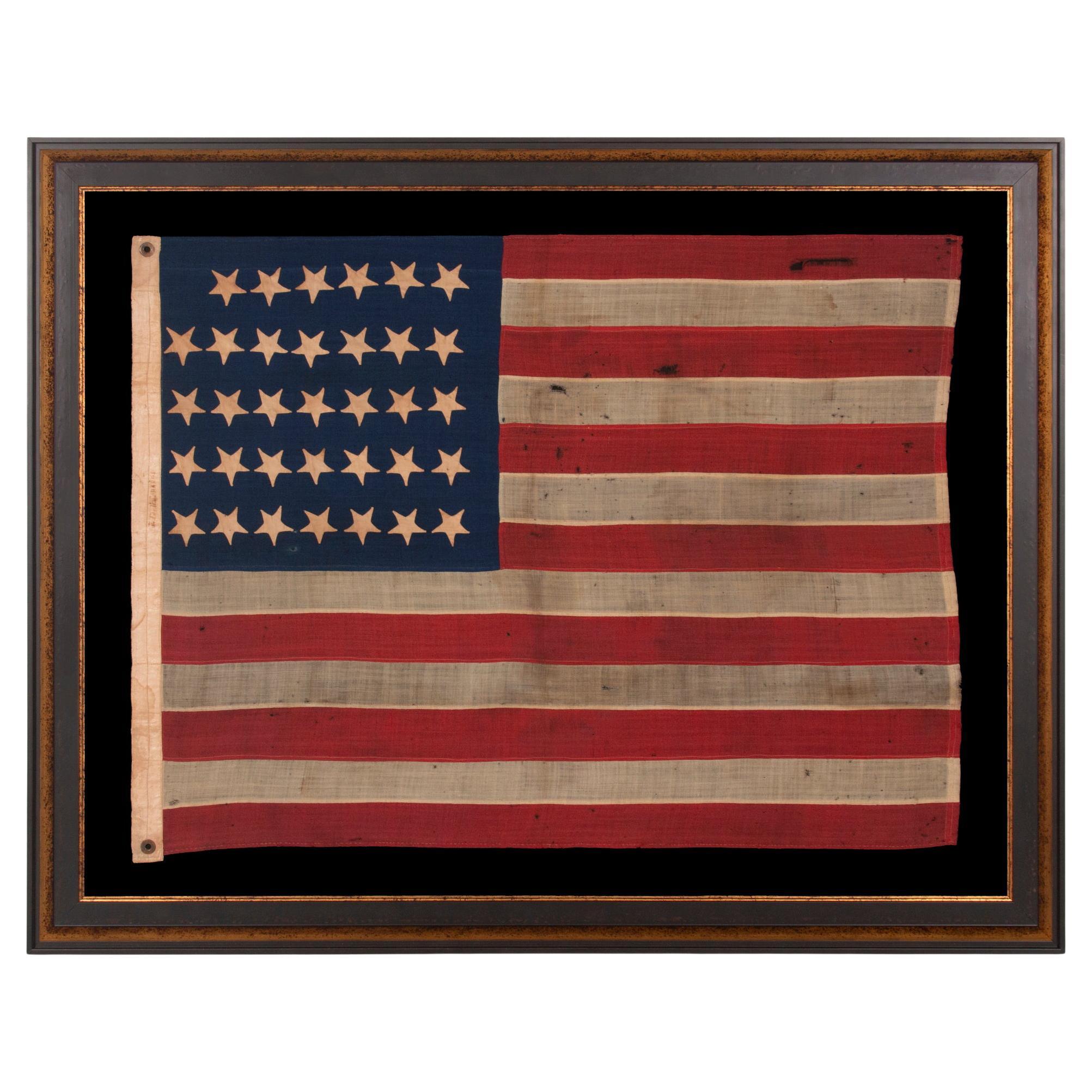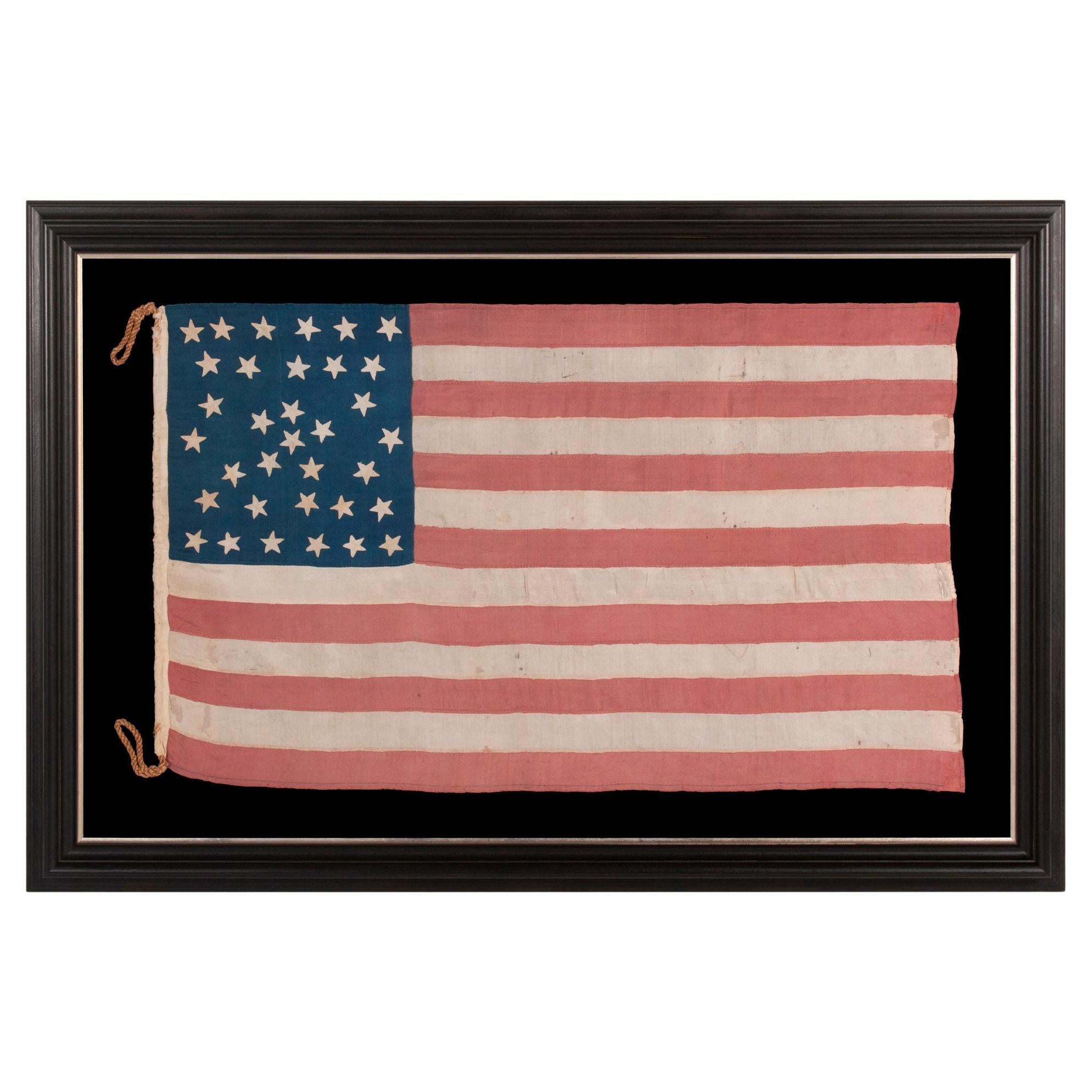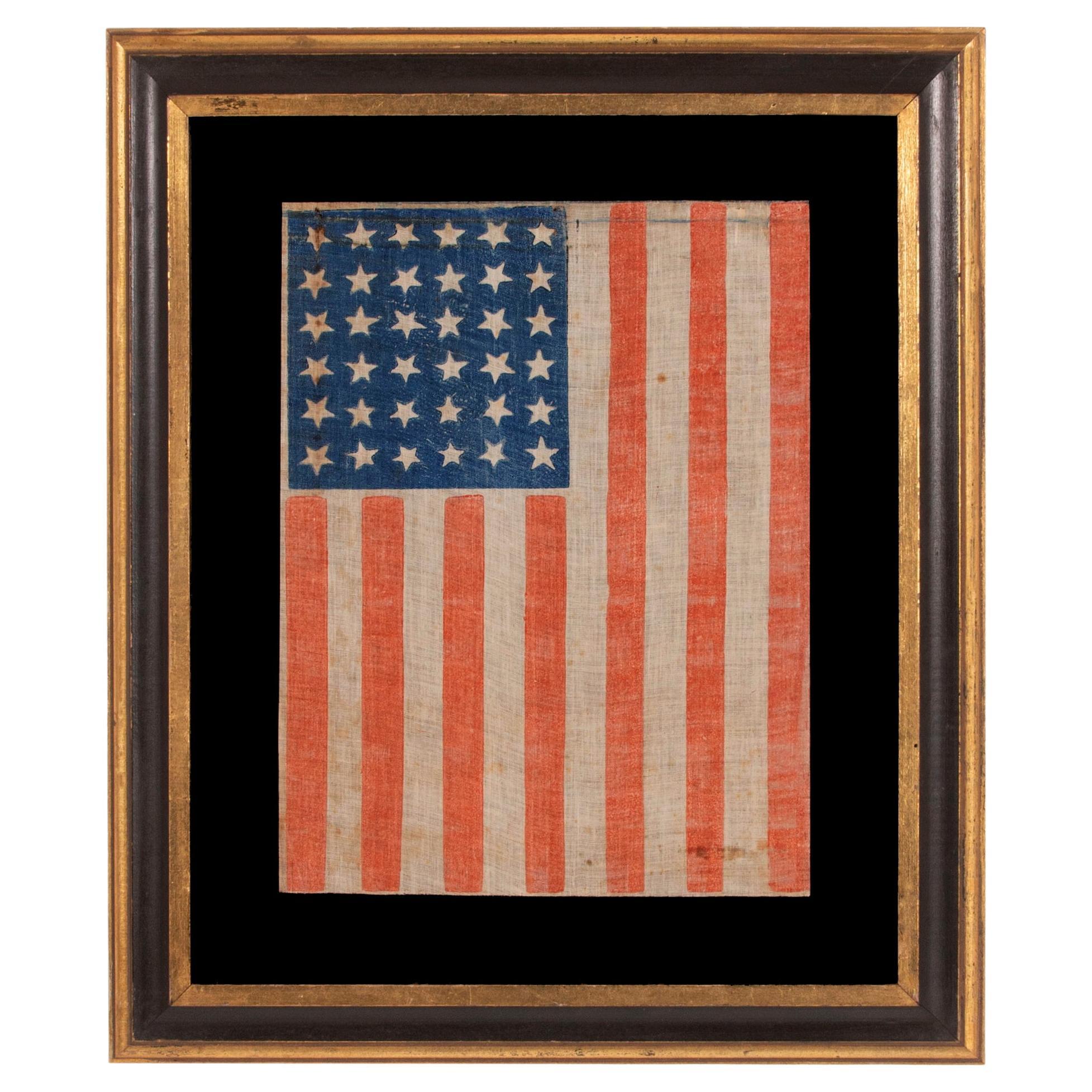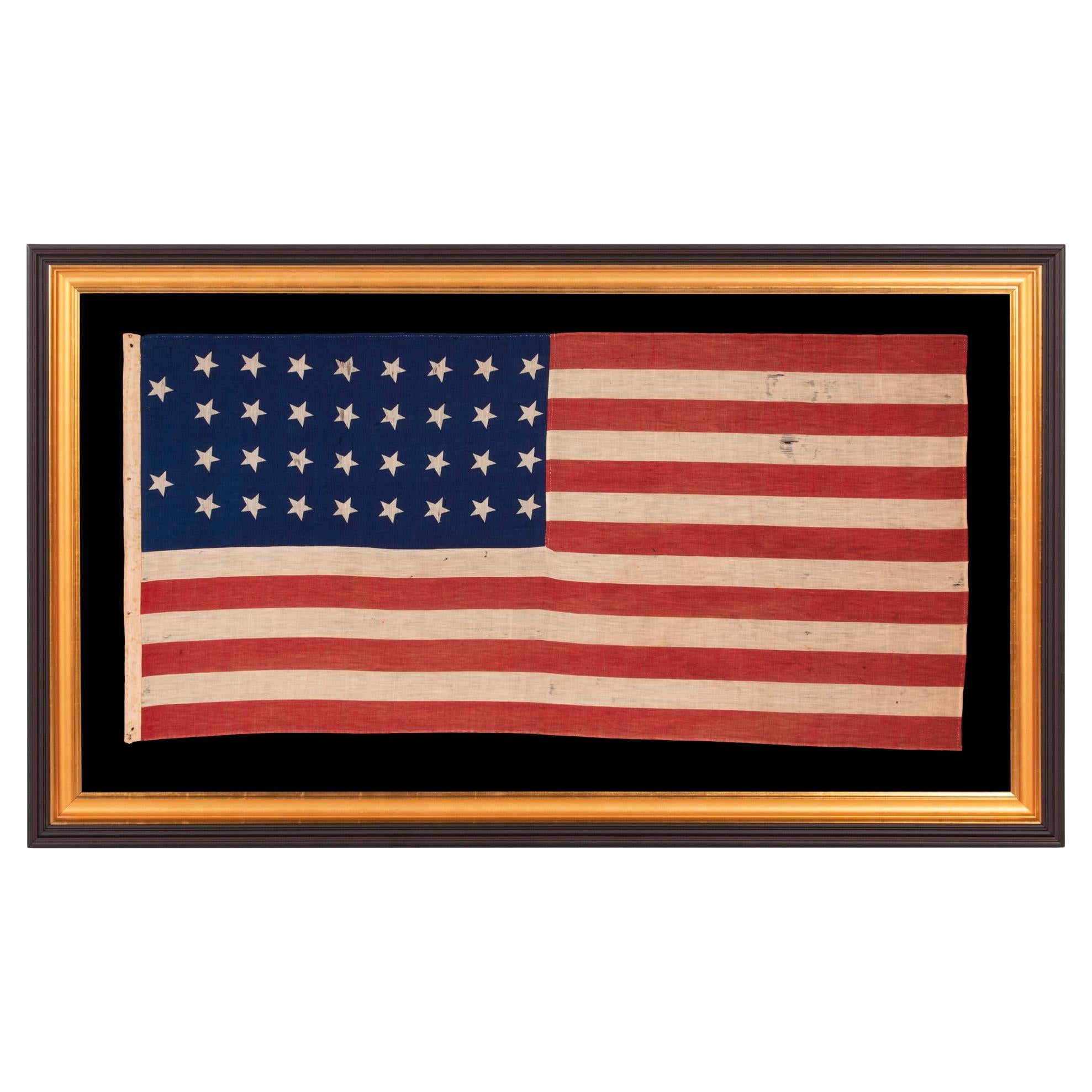Items Similar to 34 Star Antique American Parade Flag, Kansas Statehood, ca 1861-1863
Want more images or videos?
Request additional images or videos from the seller
1 of 6
34 Star Antique American Parade Flag, Kansas Statehood, ca 1861-1863
About the Item
34 STARS IN A MEDALLION CONFIGURATION ON AN ANTIQUE AMERICAN PARADE FLAG WITH A LARGE, HALOED CENTER STAR; CIVIL WAR PERIOD, KANSAS STATEHOOD, 1861-1863
34 star American national parade flag, printed on cotton and bearing a beautiful medallion configuration that has a large, haloed center star. This is one of the boldest wreath pattern designs of the Civil War era. Although the name of the maker of this flag is unknown, the company is known to have produced at least five other star counts with haloed center stars. Examples exist with 30, 31, 35, 36, and 42 stars. Three examples also exist, probably from different makers, that bear 13 stars. One dates to 1856 and was made for the presidential campaign of James Buchanan. Another was made for the 1860 presidential campaign of John Bell, who ran against Abraham Lincoln, as an independent, on the Constitutional Union Party ticket. Another style, printed on a wool and cotton blended fabric, dates to the 1876 centennial and all of its 13 stars have halos.
Within the 34 star examples with a haloed center star there are two different sizes, of which this is the larger. The larger variety tends to be better looking and the more desirable. Further, among those I have seen over the years, all of which are extremely scarce, this is one of the two nicest examples I have encountered.
Kansas was admitted into the Union as the 34th state on January 29th, 1861, about 2½ months before the Confederate assault on Fort Sumter that marked the beginning of the Civil War. The 34th star was officially added on July 4th of that year, but most flag makers would have added a 34th star with the addition of Kansas in January. The star count remained official until July 4th, 1863, and 34 star flags would have been produced until the addition of West Virginia in June of that year.
It is of interest to note that a flag in this style was discovered tacked to the staff of a political campaign torch, of a type that I believe to have been carried by the Wide Awakes Republican club in one of Lincoln’s two campaigns. If carried in 1860, the star count would have been anticipatory, since Kansas had not yet been added. The addition of stars before the respective state had even been added became common place in the second half of the 19th century, but is unusual to encounter in flags with fewer than 36 stars. Because I am not of the opinion that this style of 34 star parade flag was made prior to Kansas statehood, I suspect that the flag was added to an 1864-carried torch.
Mounting: The flag was mounted and framed within our own conservation department, which is led by expert trained staff. We take great care in the mounting and preservation of flags and have framed thousands of examples.
The flag has been hand-stitched to 100% cotton twill, black in color, that has been washed and treated for colorfastness. The exceptional half-round molding dates to the Civil War era or prior, is made of solid mahogany, and retains its original surface. The glazing is U.V. protective glass. Feel free to contact us for more details.
Condition: There is minor soiling and there are some tiny stains. There are a number of pinprick-sized holes, especially along the hoist end, where the flag was once affixed to its original wooden staff. There is minor pigment loss. Many of my clients prefer early flags to show their age and history of use. The overall condition is excellent for the period and the flag displays beautifully.
- Dimensions:Height: 19.5 in (49.53 cm)Width: 25.5 in (64.77 cm)Depth: 2 in (5.08 cm)
- Materials and Techniques:
- Place of Origin:
- Period:
- Date of Manufacture:1861-1863
- Condition:See Item Description.
- Seller Location:York County, PA
- Reference Number:
About the Seller
5.0
Recognized Seller
These prestigious sellers are industry leaders and represent the highest echelon for item quality and design.
Established in 1991
1stDibs seller since 2008
61 sales on 1stDibs
Typical response time: 10 hours
- ShippingRetrieving quote...Ships From: York County, PA
- Return PolicyThis item cannot be returned.
More From This SellerView All
- 34 Star Antique American flag, Kansas Statehood, Civil War Period, ca 1861-1863Located in York County, PA34 STAR ANTIQUE AMERICAN FLAG OF THE CIVIL WAR PERIOD (1861-63), WITH WOVEN STRIPES, PRESS-DYED STARS, AND BEAUTIFUL COLORS, POSSIBLY MADE IN NEW YORK BY THE ANNIN COMPANY, REFLECTS THE ADDITION OF KANSAS TO THE UNION, 1861-1863 34 star flag of the Civil War period, with a press-dyed canton and woven stripes. Made of a fabric produced frame a combination of wool and cotton fibers, the 34 star count was achieved in an unusual fashion, beginning with a press-dyed field of 32 star...Category
Antique 1860s American Political and Patriotic Memorabilia
MaterialsCotton
- 34 Star Flag with Upside down Hand Sewn Stars, Kansas Statehood, ca 1861-1863Located in York County, PA34 Upside-down, Hand-sewn Stars In A Notched Configuration, On An Antique American Flag Of The Civil War Period, With A Beautiful And Highly Unusual Jacquard Weave Binding, And In A Tiny Scale Among Its Counterparts, Reflects The Addition Of Kansas As The 34th State, 1861-1863 34 star American national flag with a number of interesting and desirable features. Chief among these is the scale of the flag among counterparts of the period. At just three by four feet, its size is absolutely tiny among those with pieced-and-sewn construction. During the 19th century, sewn flags (as opposed to those that were printed on cloth) were typically eight feet long and larger. This is because they were important in their function as signals, meaning that they needed to be seen and recognized from great distance. A flag that was six feet in length was considered small and production of flags smaller than this was extremely limited. Even infantry battle flags, carried on foot, were approximately six by six and-one-half feet, about the size of an average quilt of the same period. It wasn't until the 1890’s that manufacturers began to produce smaller sewn flags in great quantity. The stars of the flag are arranged in justified lineal rows, the first of which contains one fewer star. This results in what I call a “notched” design, leaving one space open for the addition of another star. The blank space leaves little doubt that the maker of the flag assumed that another Western Territory would soon acquire statehood, or that West Virginia might soon break free from Virginia, which occurred in June of 1863. Note how the stars are oriented so that they are upside-down on their vertical axis, with two points up instead of one. No one knows if this positioning bore any particular meaning. Both modern notions of the correct orientation of a star, and the present official design of the American flag, dictate that the stars are supposed to have one point up. Since there was no official design for the flag until 1912, however, it may simply be that the maker of the flag did not consider any particular position to be right-side-up or upside-down. In the mid-19th century, it was not uncommon to see stars pointing any which way, varied throughout whatever arrangement was chosen. Whatever the case may be, the feature present on this particular flag is unusual to the eye and notable in terms of its presentation. Made of cotton, the stars are hand-sewn and double-appliquéd (applied to both sides). The canton and stripes of the flag are made of wool bunting. Because blue wool bunting generally came in a width of 18", the canton was pieced from two lengths of fabric, joined by hand-stitching. The canton is joined to the striped field by hand-stitching. The stripes are pieced and hemmed by treadle stitching. Made of heavy, polished, jacquard weave linen, the binding of the flag is both exceptional from a textile connoisseur’s perspective and highly unusual. This is joined to the flag by treadle stitching. There are two brass grommets, one each at the top and bottom of the hoist, which are likewise especially unusual, in that they are both heavier than normal and intentionally hammered flat. I have seen this on only one other occasion in a Civil War flag...Category
Antique Late 19th Century American Political and Patriotic Memorabilia
MaterialsWool
- 34 Star Antique American Flag with Hourglass Medallion Stars, ca 1861-1863Located in York County, PAEXTRAORDINARY 34 STAR ANTIQUE AMERICAN FLAG WITH AN ACCORDION OR HOURGLASS MEDALLION CONFIGURATION THAT SURROUNDS A PENTAGON OF STARS IN THE CENTER; MADE OF FINE SILK AND ENTIRELY HAND-SEWN; MADE DURING THE OPENING YEARS OF THE CIVIL WAR (1861-63), IN A TINY SIZE AMONG ITS COUNTERPARTS OF THE PERIOD; REFLECTS THE ADDITION OF KANSAS AS THE 34TH STATE 34 star flag of the Civil War period with an array of rare, beautiful, and otherwise desirable features. Extremely small among flags of this period with pieced and sewn construction, the flag displays a star pattern that is not only highly unusual, but unique to this particular example. This consists of a single star in the very center, surrounded by a pentagon of stars, flanked by angular bracket of three stars to either side. Above and below are rows of 5 stars, followed by rows of 6 that line the top and bottom of the canton. The resulting configuration is what I have termed an “accordion medallion,” though “hourglass medallion” or “standing bow tie” would be perfectly acceptable. When rotated 90 degrees, to view the harder-to-identify, bow tie formation, students of early star patterns may note the visual similarity between this and what I call “Starburst” or “Crosshatch” medallions. The pattern, however, conspicuously lacks the crosses of St. Andrew (a saltire) and St. George (roman cross), that would allow it to be more accurately categorized as such. Entirely hand-sewn, the canton and stripes of the flag are made of fine silk. The hemming of this was accomplished with great skill. The top and bottom edges are selvedge. These are so similar in nature as to have come from the same maker. There is a white, silk binding along the hoist, in the form of an open sleeve, through which a length of braided hemp rope was passed, expertly looped and re-braided into itself at the top and bottom for strength. The stars are made of white, polished cotton. These were stitched to both sides (double-appliqued). Note how the edges of the fabric were not turned under, providing evidence of the fact that the maker was not especially skilled in appliqueing. This was common, as applique work was far more difficult than producing French seams. In the 19th century, most flags with pieced and sewn construction were 8 feet long and larger. A six-footer was considered small. Even military battle flags, carried on foot, measured 6’ x 6.5’, which translates into approximately 7’ x 7.5’ after framing, about the size of an average quilt and larger than can comfortably fit on a wall in a house with 8-foot ceilings and average width baseboard. Flags smaller than this were produced both commercially and at home, but the smaller they are, the more unusual they are. At just 26.5 x 46.5 inches, this flag is extremely small for a Civil war period flag with sewn construction. Silk was both beautiful and lightweight, which made it elegant for military unit colors and preferable for flags meant to be carried on foot. Most outdoor use flags...Category
Antique 1860s American Political and Patriotic Memorabilia
MaterialsSilk
- 36 Star Antique Parade Flag, Vertical Position, Nevada Statehood, ca 1861-1867Located in York County, PA36 STAR ANTIQUE AMERICAN PARADE FLAG, WITH STARS THAT ALTERNATE IN THEIR VERTICAL POSITION FROM COLUMN TO COLUMN AND ROW-TO-ROW, PRINTED ON AN ESPECIALLY INTERESTING LENGTH OF COARSE...Category
Antique Late 19th Century American Political and Patriotic Memorabilia
MaterialsCotton
- 34 STAR AMERICAN FLAG, CIVIL WAR PERIOD, 1861-63, a RARE STYLE, KANSAS STATEHOODLocated in York County, PA34 STARS IN 4 ROWS WITH 2 STARS OFFSET AT THE HOIST END, ON AN ANTIQUE AMERICAN FLAG LIKELY PRODUCED FOR MILITARY FUNCTION, AS UNION ARMY CAMP COLORS; ONE OF JUST A TINY HANDFUL THAT I HAVE ENCOUNTERED IN THIS EXACT STYLE, REFLECTS KANSAS STATEHOOD, OPENING TWO YEARS OF THE CIVIL WAR...Category
Antique 1860s American Political and Patriotic Memorabilia
MaterialsWool, Cotton
- 34 STAR AMERICAN FLAG, CIVIL WAR, 1861-63, KANSAS STATEHOOD, 2nd KY CAVALRYLocated in York County, PA34 STAR ANTIQUE AMERICAN FLAG OF THE CIVIL WAR PERIOD (1861-63), IN A TINY SCALE AMONG PIECED-AND-SEWN FLAGS OF THE PERIOD, WITH A TRIPLE-WREATH CONFIGURATION, AN ELONGATED FORMAT, AND ENTIRELY HAND-SEWN; FOUND WITH A LETTER FROM JOHN W. RUDE OF THE 2ND KENTUCKY VETERAN VOLUNTEER CAVALRY (UNION): 34 star flag of the Civil War period with a variety of extremely desirable features, handed down with a letter written by John W. Rude on November 8th, 1864, while encamped with the Army’s 1st Brigade, 3rd Division, as a member of the 2nd Regiment of Veteran Volunteer Cavalry. Tiny in scale among pieced and sewn examples, the flag displays a star pattern that consists of a three consecutive wreaths, with a single star in the very center. Because it lacks a single star in each corner, outside the basic pattern—usually present in flags of this design made during the mid-late 19th century—this is something I classify as a “snowball medallion.” Entirely hand-sewn throughout, note the square format of the blue canton, with its beautiful, circular star arrangement, and how interesting this combination is when paired with the elongated format of the flag itself. The stars are double-appliqued, meaning that they are applied to both sides. These are fat in shape and inconsistent in size. Note how the lowest star in the outermost ring actually dips into the white stripe below. Made of plain weave cotton, there is a narrow binding along the hoist, red in color, with three sets of cotton ties. Those at the top and bottom are made of fine, braided hemp or hemp and cotton cord, stitched into place, while the one in the center, looped around the binding and tied, is made of lightweight, twisted, cotton thread. Note how the 5th, 6th, and 7th red stripes are pieced from two lengths of cotton fabric, which reflects that the maker was being conscious of conserving available fabric. In the 19th century, most flags with pieced and sewn construction were 8 feet long and larger. A six-footer was considered small. Even military battle flags, carried on foot, measured 6’ x 6.5’, which translates into approximately 7’ x 7.5’ after framing, about the size of an average quilt and larger than can comfortably fit on a wall in a house with 8-foot ceilings and average width baseboard. Flags smaller than this exist, but the smaller they get, the more unusual they are. At just 1.5’ x 3’, this is about as small as one will ever encounter in a sewn flag of the Civil War era. The flag appears to have likely been hand-carried. I expect that it probably saw military use of some sort as a camp flag...Category
Antique 1860s American Political and Patriotic Memorabilia
MaterialsCotton
You May Also Like
- 34-Star Civil War American Flag, Antique Great Star Pattern, circa 1861Located in Colorado Springs, COThe stars of this extremely rare, Civil War-era flag are arranged in what is sometimes called the "Great Flower" pattern, a large star made out of smaller stars -- named as such beca...Category
Antique 1860s American Political and Patriotic Memorabilia
MaterialsLinen
- 31-Star Printed American Flag, Celebrating California Statehood, Circa 1850Located in Colorado Springs, COThis is a rare 31-star medallion printed American flag, celebrating the addition of California to the Union. The flag is printed on silk and has a spectacular “Great Star” canton pat...Category
Antique 1850s American Political and Patriotic Memorabilia
MaterialsSilk
- 1889 North Dakota 39 Star United States of America Statehood FlagLocated in Coeur d'Alene, ID39 star silk statehood flag. 23 1/2" x 15". Was the unofficial North Dakota Flag. As South Dakota was also admitted as the 40th state on the same day this...Category
Antique 1880s American Historical Memorabilia
MaterialsSilk
- 39-Star Antique American Flag with 'Whimsical' Star Pattern, 1889Located in Colorado Springs, COThis is a 39-star unofficial American flag, handmade and printed on cotton. The flag dates to 1889 and has a unique history, thanks to its rare star-count. The flag’s canton is prin...Category
Antique 1880s American Political and Patriotic Memorabilia
MaterialsCotton
- 46-Star American Flag Printed in Drum Star ConfigurationLocated in Colorado Springs, COThis is an original 46-Star American parade flag, celebrating Oklahoma statehood. Each star on the flag's canton represents a state in the Union at the time. The official flag design would update every July 4th, to include any new states added to the Union in the past year. Oklahoma, the 46th state, entered the Union on November 16, 1907. As such, this 46–star flag was the official flag of the United States from July 4, 1908, until July 4, 1912. The silk flag has a dark blue canton with 46 white printed stars. The stars are printed in an 7-8-8-8-8-7 row configuration, or “Drum design.” The flag design is completed with 13 alternating red and white stripes, each stripe representing one of the original thirteen colonies. The land that comprises Oklahoma today was added to the United States as part of the Louisiana Purchase of 1803. Throughout the 19th century, the U.S. government relocated Indian tribes from the southeastern United States to the area, and by 1900, over 30 Indian tribes had been moved to what was originally called the Indian Territories. At the same time, ranchers in Texas began to move into the area in search of new pasture lands. Although stipulations in the Indian Relocation Act agreed that the land would forever be Indian Territory, the promise of fertile farmland trumped the government’s promise of sovereignty. On April 22, 1889, they opened the land to settlement by homesteaders, creating a land run in which settlers, called “Boomers,” were allowed to cross the Texas or Arkansas border at a particular hour to claim homesteads. Settlers who illegally crossed the border earlier to stake prime land were called “sooners,” which eventually became the state’s nickname. Wagons and the Santa Fe railroad carried cartloads of men and women to blank town sites and building plots, creating ten thousand-people communities in a matter of days. The following year, the region was further divided into Indian Territory and Oklahoma Territory...Category
Vintage 1910s American Political and Patriotic Memorabilia
MaterialsSilk
- Original Painted Metal Parade FlagLocated in Los Angeles, CAThis fun and folky 20thc original painted parade flag sign was used to hand in the windows during patriotic events. In stores and homes in the early 20thc.Category
Antique Late 19th Century American Adirondack Political and Patriotic Me...
MaterialsTin
Recently Viewed
View AllMore Ways To Browse
Modern Pennants
Flag Pole With Eagle
Korean Flag
Folk Art American Eagle
Antique American Flag 49 Stars
Chinese Porcelain Lunch Box
Pennant Banner
Prints Men In Confederate Uniform
Star Wars Prop
Hermes Scarf Folk
Toy Sewing Machine
Uss Utah
A Moderate Gale
Antique Jewelry Lancaster Pa
Grand Duchess Tatiana
Rosenthal Iwo Jima
Toy Singer Sewing Machine
Buermann Spurs





